To capture epic car chases, master low-altitude tracking shots for intense speed perception. Utilize dynamic camera movements, balancing handheld and stabilized techniques. Exploit tight urban environments with strategic camera placements. Incorporate dramatic aerial perspectives using drones or helicopters. Perfect high-speed follow shots with specialized camera vehicles. Seamlessly shift between ground and aerial footage. Optimize for challenging weather conditions to add visual drama. Choreograph complex multi-vehicle sequences for maximum impact. Enhance shots with post-production effects like motion blur and color grading. Finally, focus on visual storytelling to engage your audience emotionally. These techniques will elevate your car chase scenes to heart-pounding cinematic experiences.
Master Low-Altitude Tracking Shots
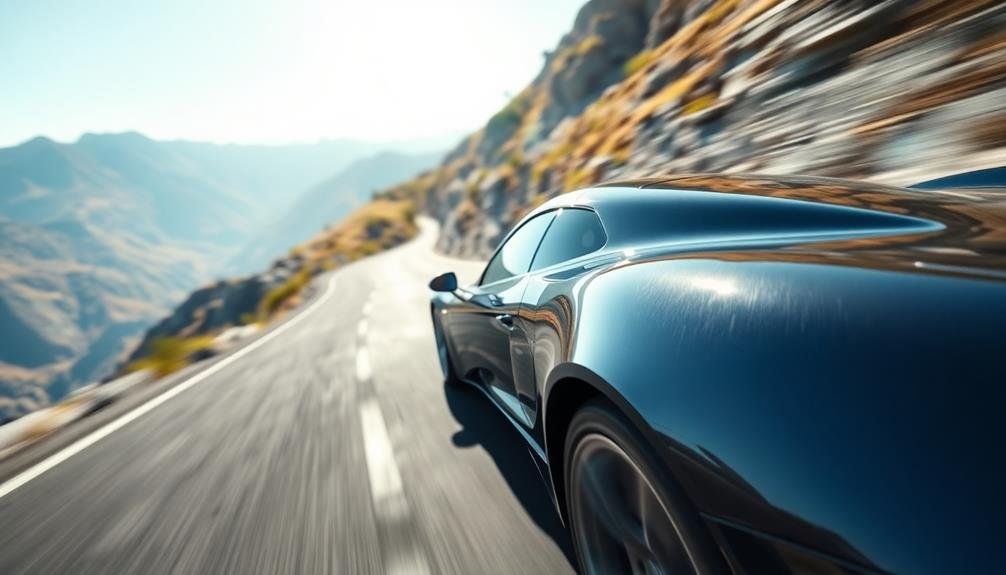
Low-altitude tracking shots are the bread and butter of car chase cinematography. To master these shots, you'll need to invest in the right equipment. Start with a stabilized camera system, like a gyro-stabilized mount or a drone with advanced gimbal technology. These tools will help you achieve smooth, steady footage even at high speeds.
When setting up your shot, position the camera as close to the ground as safely possible. This creates a heightened sense of speed and danger. Experiment with different angles, from side tracking to following directly behind the vehicle. Each perspective adds a unique dynamic to the chase sequence.
Pay attention to your surroundings. Use the environment to frame your shots and add visual interest. Incorporate obstacles like trees, buildings, or other vehicles to create a sense of depth and increase tension.
Timing is essential. Coordinate with the stunt team to guarantee you're capturing the most exciting moments. Practice your movements to anticipate the vehicle's path and maintain peak framing throughout the sequence.
Utilize Dynamic Camera Movements
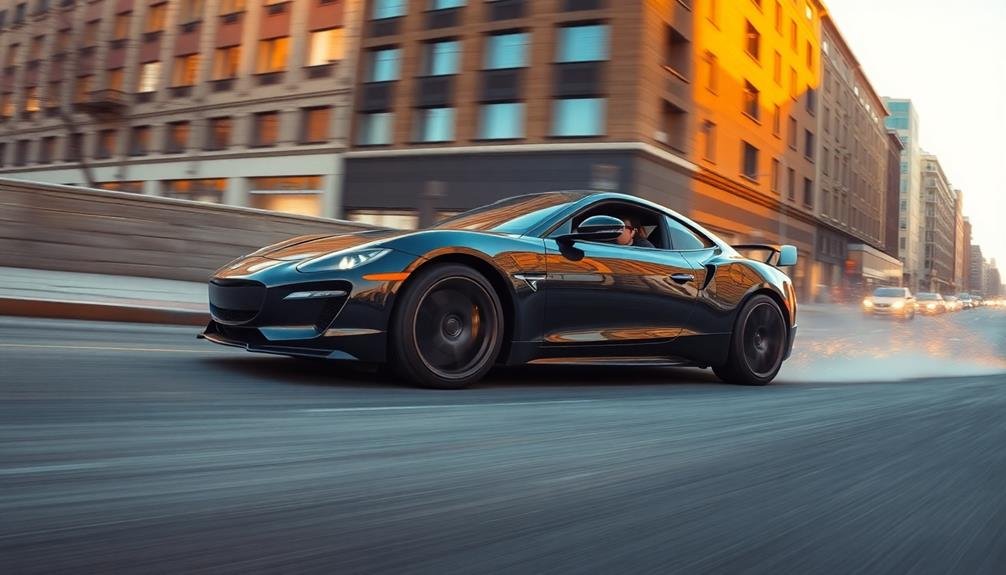
When filming car chases, you'll need to decide between handheld and stabilized shots to capture the right energy and mood.
Handheld shots can convey urgency and chaos, while stabilized shots offer smoother, more controlled visuals.
For a bird's-eye view of the action, consider using drones to capture stunning aerial perspectives that add depth and scale to your chase sequences.
Handheld vs. Stabilized Shots
During intense car chases, the camera's movement can make or break the scene's impact. You'll need to decide between handheld and stabilized shots to create the desired effect.
Handheld shots can add a raw, chaotic feel to your chase, immersing viewers in the action. They're great for POV shots from inside the car or for capturing the frantic energy of pursuing vehicles. However, overuse can lead to a disorienting experience.
Stabilized shots, on the other hand, offer a smoother, more controlled perspective. They're ideal for showcasing the speed and precision of the vehicles, as well as capturing wide, sweeping views of the chase landscape. Use stabilized shots to establish the geography of the scene and to give viewers a moment to catch their breath between intense handheld sequences.
The key is to strike a balance between the two techniques. Mix handheld and stabilized shots to create a dynamic visual experience. Use handheld for close-ups and intense moments, then switch to stabilized for wider shots and to showcase the environment.
This combination will keep your audience engaged and on the edge of their seats throughout the car chase sequence.
Drones for Aerial Perspectives
Drones have revolutionized aerial cinematography for car chases, offering unparalleled flexibility and dynamic perspectives. You'll find that these nimble devices can capture sweeping overhead shots, seamless follow shots, and dramatic reveals that were once impossible or prohibitively expensive.
To maximize your drone footage, plan your shots carefully. Scout locations beforehand and map out flight paths that complement the chase sequence. Consider the terrain and obstacles, ensuring your drone can safely navigate the area while capturing the action.
Use a variety of altitudes and angles to add visual interest. Low-flying drones can create a sense of speed and immediacy, while higher altitudes provide context and showcase the surrounding environment. Experiment with reveal shots, starting high and descending as cars round a corner or emerge from behind obstacles.
Master smooth, fluid movements to enhance the cinematic quality. Practice panning, tracking, and orbiting techniques to keep pace with the vehicles. Utilize intelligent flight modes like ActiveTrack to automatically follow the action, freeing you to focus on framing and composition.
Remember to adhere to local regulations and obtain necessary permits when flying drones for commercial filmmaking. Safety should always be your top priority.
Capture Tight Urban Environments
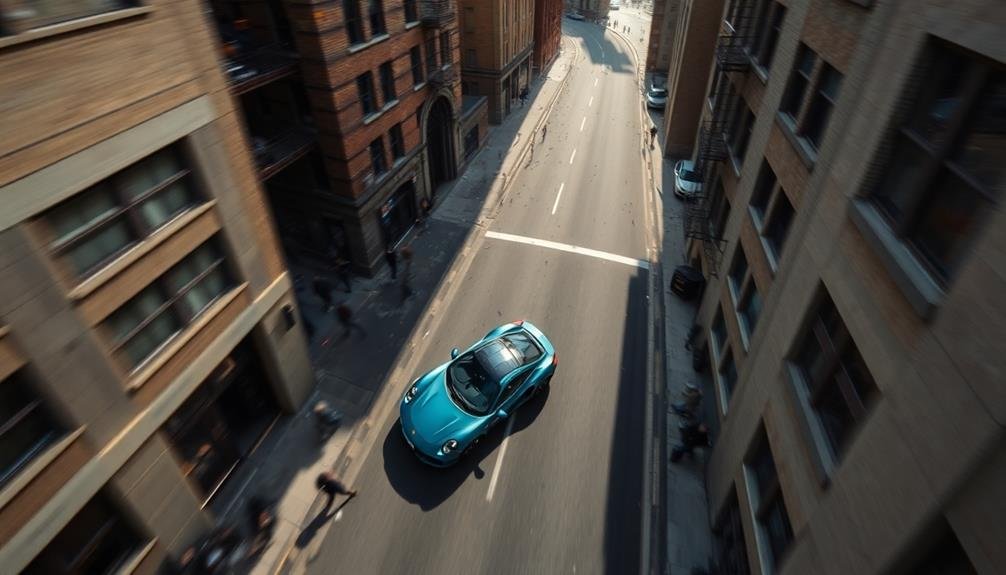
In tight urban environments, capturing the intensity of a car chase requires careful planning and execution. You'll need to scout locations beforehand, identifying narrow streets, alleyways, and sharp turns that can add excitement to your sequence.
Consider using a combination of handheld cameras and stabilized rigs to achieve a dynamic feel while maintaining control.
Utilize wide-angle lenses to emphasize the closeness of buildings and obstacles, creating a sense of claustrophobia and urgency. Position cameras strategically at street corners and intersections to capture the action from multiple angles.
Don't forget to incorporate low-angle shots that showcase the vehicles' speed and proximity to the ground.
To enhance the urban atmosphere, make use of practical effects like tire smoke, sparks from scraping metal, and debris. These elements will add realism and intensity to your chase scenes.
When possible, incorporate iconic city landmarks or recognizable street features to ground the action in a specific location.
Remember to prioritize safety when filming in busy urban areas. Coordinate with local authorities, obtain necessary permits, and use professional stunt drivers to guarantee a smooth and secure shoot.
Incorporate Dramatic Aerial Perspectives
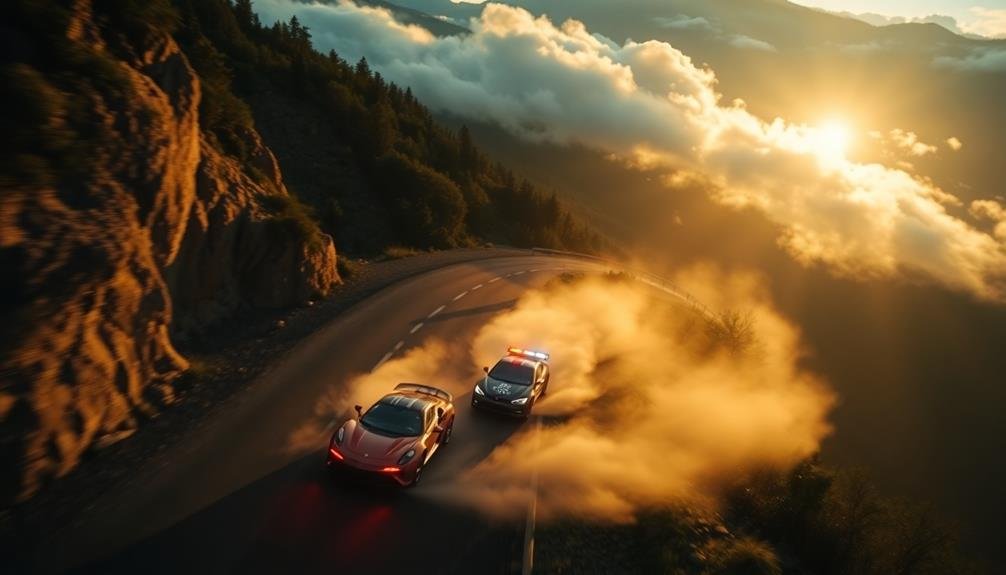
Aerial perspectives can dramatically elevate your car chase cinematography, providing a unique and exhilarating viewpoint for viewers. To incorporate these shots, you'll need to use drones or helicopters. Drones offer more flexibility and cost-effectiveness for tighter spaces, while helicopters provide stability for longer, high-speed chases.
When planning your aerial shots, consider the following:
| Shot Type | Purpose | Best Used For |
|---|---|---|
| Wide Establishing | Set the scene | Beginning of chase |
| Follow Shot | Track vehicles | Straight stretches |
| Orbit | Show 360° view | Roundabouts or turns |
| Top-Down | Reveal chase patterns | Complex maneuvers |
To capture the best aerial footage, communicate clearly with your pilot and use a gimbal-stabilized camera. Plan your shots in advance, considering the chase route and potential obstacles. Remember to vary your altitudes and angles to create visual interest and maintain the audience's engagement.
Don't forget to integrate these aerial perspectives seamlessly with your ground-level shots. Use smooth shifts and match the pacing of your edits to the intensity of the chase. By incorporating dramatic aerial views, you'll add depth and excitement to your car chase sequences.
Perfect High-Speed Follow Techniques
While aerial shots offer a grand perspective, mastering high-speed follow techniques is vital to capturing the heart-pounding action on the ground. To perfect these techniques, you'll need a combination of skill, preparation, and the right equipment.
Start by selecting a vehicle that can keep up with the chase cars. A high-performance SUV or sports car is often ideal, providing stability and speed. Equip your camera car with a gyro-stabilized mount to guarantee smooth footage, even at high speeds.
Practice coordinating with your driver to anticipate movements and maintain the best distance from the action. Use long lenses to compress space and create a sense of urgency. When possible, employ a low angle to emphasize speed and make the vehicles appear more imposing.
Consider using multiple camera cars to capture different angles simultaneously. This approach allows for dynamic editing and guarantees you don't miss significant moments.
Remember to prioritize safety at all times, maintaining clear communication with all crew members and adhering to traffic laws.
Exploit Natural Obstacles Creatively
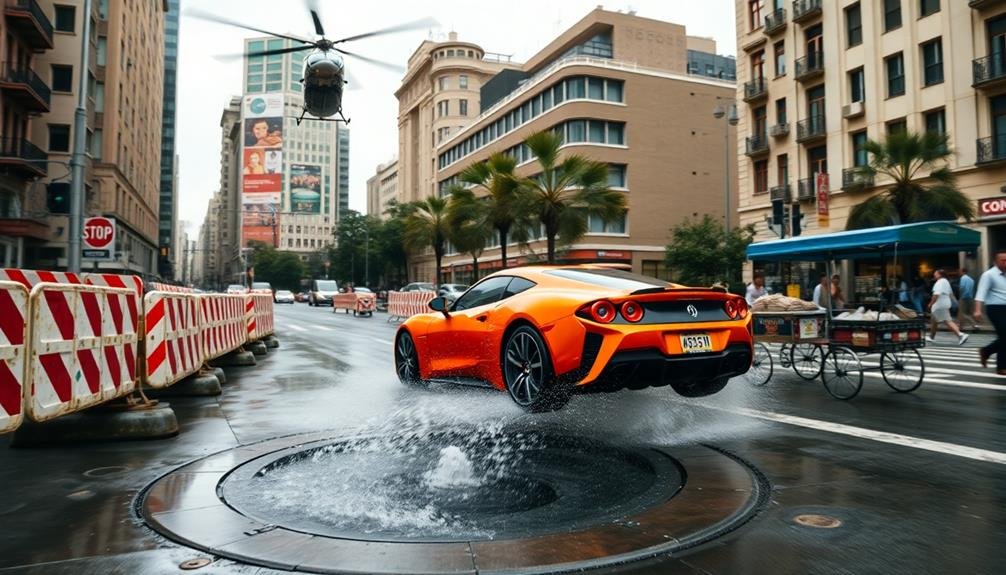
Natural obstacles can spice up your car chase cinematography, adding depth and excitement to your scenes. Look for unique terrain features that can enhance the visual drama. Utilize winding mountain roads to create tension as cars navigate hairpin turns. Incorporate tunnels for dramatic light changes and echoing engine sounds. Exploit narrow alleys in urban settings to amplify the sense of speed and danger.
Consider water features like puddles or wet roads for spectacular spray effects. Beach scenes offer opportunities for sand kicks and dune jumps. In rural areas, use cornfields or tall grass to partially obscure vehicles, building suspense.
Don't overlook man-made obstacles like construction sites, parking garages, or busy intersections.
When filming, position your cameras to maximize the impact of these obstacles. Use low angles to emphasize car proximity to barriers. Employ drone shots to showcase the broader landscape and car trajectories. Experiment with mounting cameras on obstacles themselves for unique perspectives.
Seamlessly Transition Between Drones
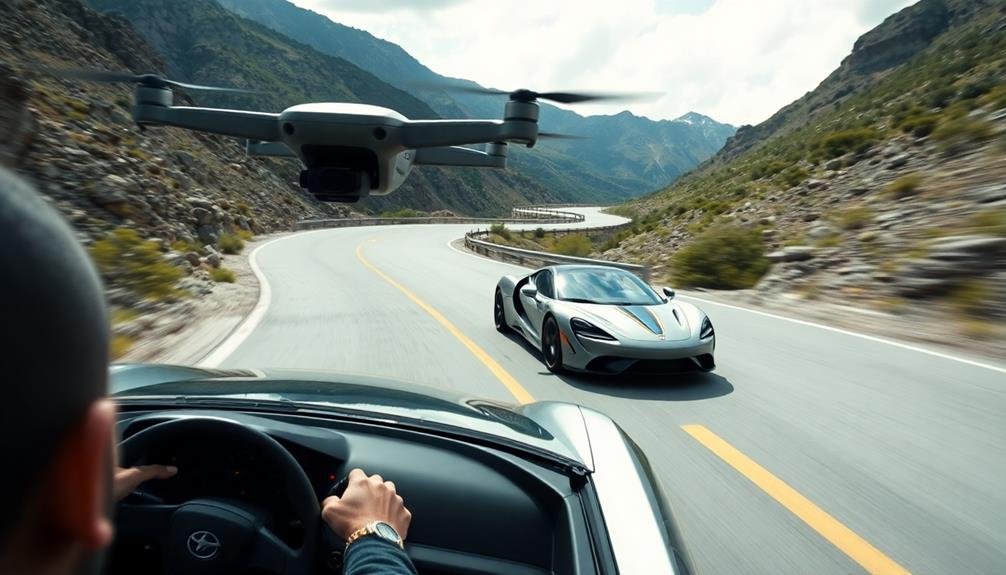
Three key techniques will help you seamlessly shift between drones during car chase cinematography.
First, plan your drone handoffs in advance. Map out specific points along the chase route where you'll switch drones, ensuring each interchange occurs at a visually interesting moment. This forethought will create a smooth flow between shots and maintain the scene's energy.
Second, use matching flight paths and camera movements. As one drone nears its handoff point, have the next drone mimic its trajectory and framing. This continuity will make the switch nearly imperceptible to viewers. Practice these coordinated movements with your drone pilots before the actual shoot.
Lastly, leverage natural elements to mask interchanges. Time your drone switches to coincide with the cars passing behind buildings, trees, or other obstructions. You can also use quick pans or intentional motion blur to disguise the handoff.
In post-production, add subtle transitions like cross-fades or wipes to further blend the footage.
Optimize for Challenging Weather Conditions
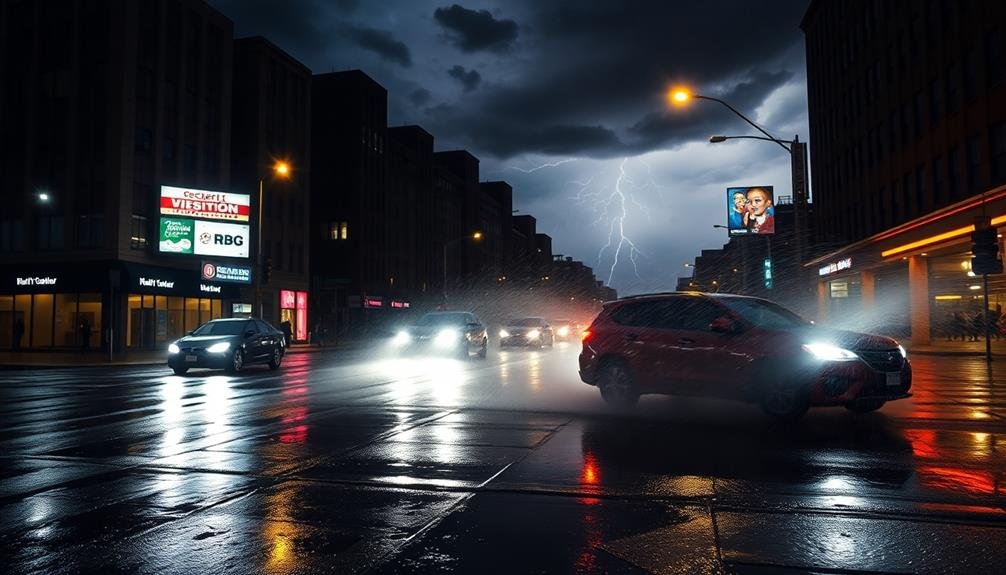
Despite the best-laid plans, challenging weather conditions can throw a wrench into your car chase cinematography. To optimize for these scenarios, you'll need to adapt quickly and use the weather to your advantage.
In rain, capture the spray from tires and reflections on wet roads to add drama. Use rain deflectors on your camera lenses to keep shots clear, and consider waterproof housings for your equipment.
For foggy conditions, embrace the atmosphere by using longer focal lengths to create a sense of mystery and depth. Utilize practical lighting from the vehicles to cut through the haze and create striking visuals.
In snow, leverage the stark white backdrop to highlight the vehicles' movements and create contrast.
When dealing with harsh sunlight, use polarizing filters to reduce glare and enhance colors. Plan your shots to take advantage of golden hour lighting for a cinematic look.
In low-light situations, opt for faster lenses and higher ISO settings to maintain image quality. Remember to adjust your white balance for different lighting conditions to guarantee consistent color throughout your footage.
Choreograph Complex Multi-Vehicle Sequences
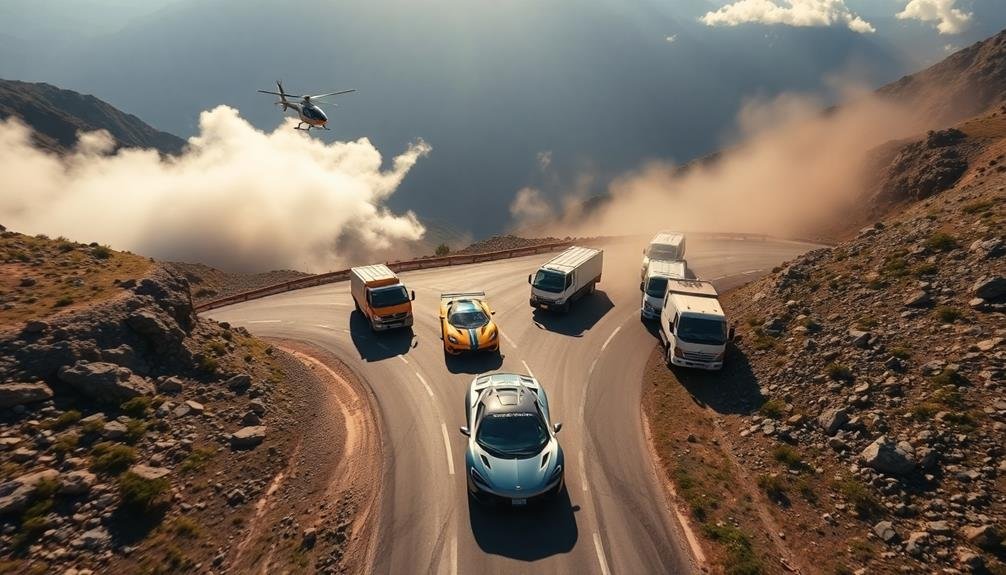
Choreographing a multi-vehicle chase sequence is like orchestrating a high-speed ballet on wheels. You'll need to meticulously plan each vehicle's movements, ensuring they interact seamlessly while maintaining tension and excitement.
Start by storyboarding the entire sequence, mapping out key moments and camera angles. Consider the unique characteristics of each vehicle involved, such as speed, maneuverability, and size. Use these traits to create dynamic interactions and near-misses that'll keep viewers on the edge of their seats.
Incorporate varied terrain and obstacles to add complexity and challenge to the pursuit. When filming, use multiple cameras to capture different angles simultaneously. This'll give you more options in the editing room and help maintain continuity.
Coordinate with your stunt team to execute precise maneuvers safely, and use a mix of practical effects and CGI to enhance the scene's impact. Remember to vary the pacing throughout the sequence. Alternate between high-speed chases and slower, tension-building moments to create a rhythm that keeps the audience engaged.
Enhance Shots With Post-Production Effects
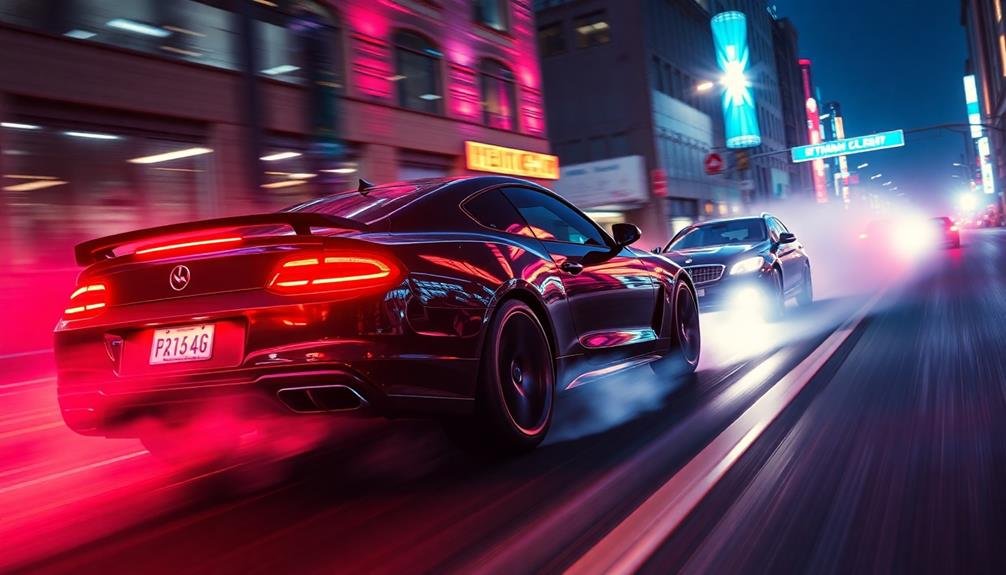
Once you've captured your thrilling car chase footage, you can elevate its impact through post-production effects.
Start by applying color grading techniques to intensify the mood and atmosphere of your scenes.
Don't forget to add digital camera shake and incorporate dynamic motion blur to enhance the sense of speed and urgency in your final cut.
Color Grading for Intensity
Enhancing the intensity of car chase scenes through color grading is a crucial post-production step. You'll want to focus on creating a high-contrast look that emphasizes the adrenaline-pumping nature of the chase.
Start by adjusting the overall color temperature to create a cooler or warmer tone, depending on the mood you're aiming for. Boost the saturation of specific colors to make them pop, particularly reds and oranges for brake lights and explosions.
Increase the contrast to deepen shadows and brighten highlights, creating a more dynamic visual experience. Don't shy away from using vignettes to draw attention to the center of the frame and add a sense of urgency.
Consider using split-toning techniques to add complementary colors to the shadows and highlights, further enhancing the visual drama. You can also experiment with desaturating certain colors while boosting others to create a unique look that sets your chase scene apart.
Remember to maintain consistency throughout the sequence, ensuring that each shot flows seamlessly into the next. By skillfully applying these color grading techniques, you'll elevate the intensity of your car chase scene and keep viewers on the edge of their seats.
Adding Digital Camera Shake
Digital camera shake can transform a stable shot into a pulse-pounding moment of action. In post-production, you can add this effect to enhance the intensity of your car chase scenes.
Start by analyzing the movement in your footage to determine the appropriate direction and intensity of the shake. Use your editing software's built-in camera shake effects or third-party plugins to apply the shake.
Adjust parameters like amplitude, frequency, and randomness to create a realistic feel. Remember, less is often more – subtle shakes can be more effective than exaggerated ones.
Experiment with different shake patterns for various scenarios. For example, use a side-to-side shake for sharp turns, and up-and-down motion for bumpy roads. Gradually increase the intensity as the chase escalates, but be careful not to overdo it and cause viewer discomfort.
To maintain continuity, apply consistent shake across multiple shots within the same sequence. Pay attention to the shake's interaction with other visual elements, such as lens flares or motion blur.
Incorporating Dynamic Motion Blur
Motion blur is a powerful tool for enhancing the sense of speed and intensity in car chase scenes. When applied dynamically, it can create a visceral feeling of movement that draws viewers into the action.
In order to incorporate dynamic motion blur effectively, you'll need to adjust your settings based on the speed and direction of your shots. Start by analyzing your footage and identifying key moments where motion blur would have the greatest impact.
Apply the effect sparingly to maintain a balance between realism and visual excitement. Use directional blur to emphasize the path of moving vehicles, and radial blur to simulate the effect of rapid acceleration or sudden stops.
Don't forget to take into account the camera's movement when applying motion blur. If you're using a tracking shot, add blur to the background while keeping the subject in focus.
For whip pans or quick camera movements, increase the blur intensity to sell the rapid change in perspective. Experiment with different blur strengths and durations to find the sweet spot for each shot.
Frequently Asked Questions
How Do You Ensure the Safety of Stunt Drivers During Car Chases?
You'll prioritize safety by hiring experienced stunt drivers, using well-maintained vehicles, and planning routes carefully. You should conduct thorough rehearsals, have medical staff on standby, and use protective gear. Don't forget to follow all local traffic laws.
What Are the Legal Requirements for Filming Car Chases on Public Roads?
You'll need permits from local authorities, traffic control plans, and safety measures in place. Make certain you've notified residents, obtained insurance, and followed speed limits. Don't forget to hire professional stunt drivers and have medical personnel on standby.
How Do You Synchronize Multiple Cameras for Seamless Editing in Post-Production?
You'll want to use timecode sync for all cameras. Start by jamming timecode at the beginning of the shoot. Use a clapper board or flash to mark sync points. This guarantees smooth editing between multiple angles later.
What Specialized Equipment Is Essential for Capturing High-Quality Audio During Car Chases?
You'll need wireless lavalier mics for in-car dialogue, shotgun mics for exterior sounds, and a portable mixer. Don't forget windscreens for outdoor recording. A boom operator in a separate vehicle can capture additional audio if needed.
How Do You Create the Illusion of Speed Without Endangering the Crew?
You can create the illusion of speed safely by using low-angle shots, shaky cam techniques, and wind machines. You'll also want to employ clever editing, sound effects, and camera tricks like undercranking to enhance the sense of velocity.
In Summary
You've now got the tools to create jaw-dropping car chase scenes that'll leave audiences on the edge of their seats. Remember, it's all about capturing the speed, intensity, and danger of the chase. Don't be afraid to experiment with different techniques and push the boundaries of what's possible. With practice and creativity, you'll be shooting heart-pounding pursuits that rival Hollywood's best. Now get out there and start filming some epic car chases!

As educators and advocates for responsible drone use, we’re committed to sharing our knowledge and expertise with aspiring aerial photographers.
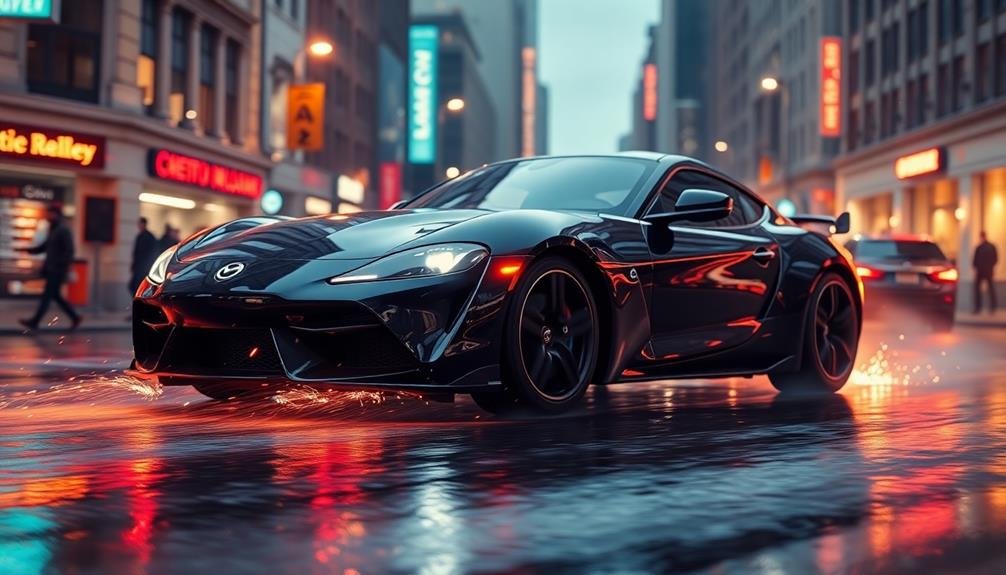



Leave a Reply